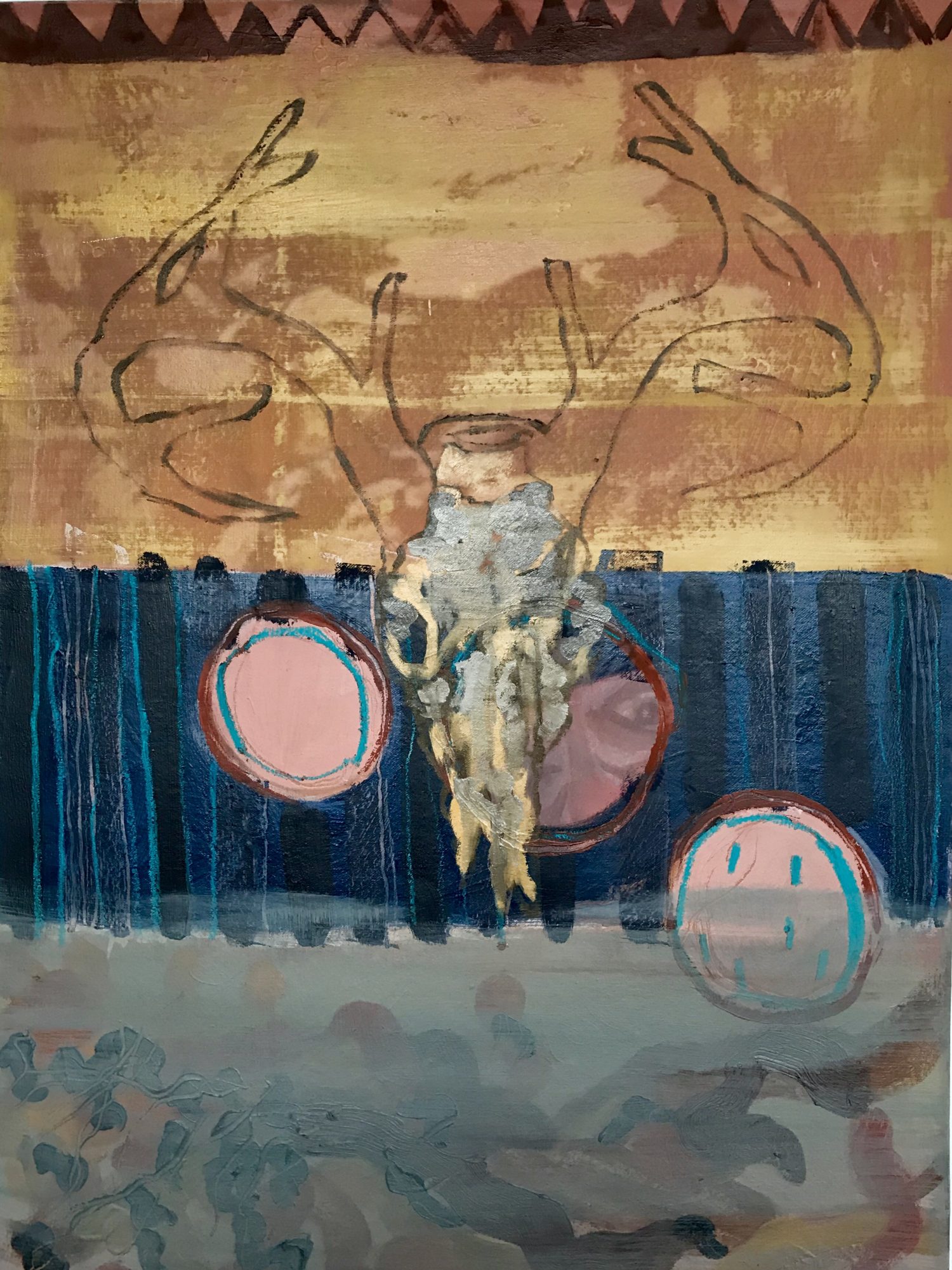[cmsmasters_row][cmsmasters_column data_width=”1/1″][cmsmasters_text]
What is your typical studio routine?
I start by checking all my canvases – I usually have at least 10 paintings on the go. I come in and assess them, see if any of them have miraculously evolved in the night, usually they look like they have lost something that I can’t put my finger on, so I begin painting.
I sit for maybe an hour mixing colours and checking the tones against the paintings with my palette knife. As I said, I usually have a lot on the go so I jig the canvases around, put some on the floor, some next to each other to pair them, and so on. I check the colours on my palette knife against the colours already set, and mix them until they are just right – that fleeting moment a painter gets when the new colours are sitting, luscious, ready to use, you’re ready to pounce. Then I’ll add to my paintings from the painting plan I’ll have drawn or made out of collage – it’s usually a solid plan but other images or artists work interrupts my plan and takes over.
I take a lot of progress photos, this helps for finding fresh ways of looking at work (last thing at night, for example). Then I compare them to the previous chapter in the process, and figure out if I have ruined it or not.
But really, the fun part is reaching a point in a painting that you didn’t expect, or that takes you off guard by one movement, one gesture or one idea, that makes the entire painting. And you know it’s the right step, and you follow it through.
This doesn’t happen every routine, but it’s definitely something I try to make a casual thing.
Was there a definitive point in your life that you decided to become a professional artist?
I think when I turned 3. I decided to become a professional artist because I got to draw on walls.
Honestly though, it’s something I have always had, it gave me such an intense feeling of happiness, even from such a young age, I was never going to not do it.
Professionally I need to put myself out there a lot more, and do more admin, but I’m definitely learning a lot about the business side of things after coming out of University, so this is something I am building on too.
It’s hard going but it’s something I will stick to because I love it so much and it’s a form of therapy. I’m in it for the long game!
Many of us at QSS have previously studied at the Ulster University at different stages of our education (BA, MFA, PHD). How did this experience influence your later attitude as a professional working artist?
I recently finished the MFA in the Ulster University – probably the best decision I made in 25 years. Studying art seriously in my mid-twenties is something I will always be grateful for, and something I’ll never forget.
Best two years of my life. I met amazing artists who I now can say are my friends, I was taught by fantastic tutors, second to none and I was painting all day every day.
Finishing the masters was tough – going from intense study and constant painting to having to get a full-time job was hard to adjust to – it was sad too. But then I got into QSS with loads of amazing artists and now the new gallery is up and running. It’s a great spot and something I am immensely proud of.
Being plonked in at the deep end is disconcerting at times, but being a professional working artist requires self-discipline, courage and passion. Things I learned in the BA, and built on in the Masters.
[/cmsmasters_text][/cmsmasters_column][/cmsmasters_row][cmsmasters_row data_width=”boxed” data_padding_left=”3″ data_padding_right=”3″ data_top_style=”default” data_bot_style=”default” data_color=”default” data_bg_position=”top center” data_bg_repeat=”no-repeat” data_bg_attachment=”scroll” data_bg_size=”cover” data_bg_parallax_ratio=”0.5″ data_padding_top=”0″ data_padding_bottom=”50″ data_padding_top_large=”0″ data_padding_bottom_large=”0″ data_padding_top_laptop=”0″ data_padding_bottom_laptop=”0″ data_padding_top_tablet=”0″ data_padding_bottom_tablet=”0″ data_padding_top_mobile_h=”0″ data_padding_bottom_mobile_h=”0″ data_padding_top_mobile_v=”0″ data_padding_bottom_mobile_v=”0″ data_shortcode_id=”monpoj87qc”][cmsmasters_column data_width=”1/1″ data_bg_position=”top center” data_bg_repeat=”no-repeat” data_bg_attachment=”scroll” data_bg_size=”cover” data_border_style=”default” data_animation_delay=”0″ data_shortcode_id=”m6r4vasll3″][cmsmasters_image shortcode_id=”jn7llpq40n” align=”none” caption=”Pink Skull, oil on canvas, 20 x 15 cm” animation_delay=”0″]6935|http://www.queenstreetstudios.net/wp-content/uploads/2019/08/Pink-Skull-e1565282766722.jpeg|full[/cmsmasters_image][/cmsmasters_column][/cmsmasters_row][cmsmasters_row data_shortcode_id=”txzg2znr5b” data_padding_bottom_mobile_v=”0″ data_padding_top_mobile_v=”0″ data_padding_bottom_mobile_h=”0″ data_padding_top_mobile_h=”0″ data_padding_bottom_tablet=”0″ data_padding_top_tablet=”0″ data_padding_bottom_laptop=”0″ data_padding_top_laptop=”0″ data_padding_bottom_large=”0″ data_padding_top_large=”0″ data_padding_bottom=”50″ data_padding_top=”0″ data_bg_parallax_ratio=”0.5″ data_bg_size=”cover” data_bg_attachment=”scroll” data_bg_repeat=”no-repeat” data_bg_position=”top center” data_color=”default” data_bot_style=”default” data_top_style=”default” data_padding_right=”3″ data_padding_left=”3″ data_width=”boxed”][cmsmasters_column data_width=”1/1″ data_shortcode_id=”to4ab2p4hb” data_animation_delay=”0″ data_border_style=”default” data_bg_size=”cover” data_bg_attachment=”scroll” data_bg_repeat=”no-repeat” data_bg_position=”top center”][cmsmasters_text shortcode_id=”t5l3ck5cx” animation_delay=”0″]
The full list of questions to choose from is given below:
1. What is your typical studio routine?
2. Was there a definitive point in your life that you decided to become a professional artist?
3. Many of us at QSS have previously studied at the University of Ulster at different stages of our education (BA, MFA, PHD). How did this experience influence your later attitude as a professional working artist?
4. Socially, historically and perhaps geographically, Belfast has many ‘unique’ attributes that define it as a city. Can you describe one positive and one negative aspect of working in this ‘unique’ place?
5. There are many art journals, which would you consult regularly?
6. What role does social media play in the documentation/promotion of your own work?
7. Is there a difference, say, in being called an ‘artist’ or a ‘painter’/’sculptor’/’printmaker’? Do these distinctions matter?
8. How do you find an audience beyond the studio?
9. Have you completed any artist residencies or are there any you aspire to?
10. Can you name some of the contemporary artists you are interested in?
[/cmsmasters_text][/cmsmasters_column][/cmsmasters_row]

